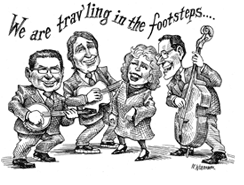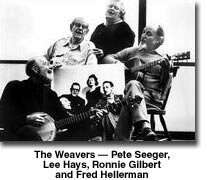 Work o’ the Weavers’ very first performance was for an audience of one: none other than Weavers founding member Pete Seeger himself, who scribbled notes in the margins of the narrative to assure accuracy of fact and chronology. In 2003, the new quartet debuted their affectionate homáge at Hudson Valley’s venerable Walkabout Clearwater Coffeehouse (with Fred Hellerman in the front row – he later joined them onstage for Goodnight Irene). Not only is 2013 their 10th year of celebrating The Weavers and their inestimable legacy, but it’s also coincidentally the 65th Anniversary of The Weavers’ very first public performance in 1948.
Work o’ the Weavers’ very first performance was for an audience of one: none other than Weavers founding member Pete Seeger himself, who scribbled notes in the margins of the narrative to assure accuracy of fact and chronology. In 2003, the new quartet debuted their affectionate homáge at Hudson Valley’s venerable Walkabout Clearwater Coffeehouse (with Fred Hellerman in the front row – he later joined them onstage for Goodnight Irene). Not only is 2013 their 10th year of celebrating The Weavers and their inestimable legacy, but it’s also coincidentally the 65th Anniversary of The Weavers’ very first public performance in 1948.
Faithful to the Weavers’ original arrangements, Work o’ the Weavers (David Bernz, James Durst, Mark Murphy & Martha Sandefer) recalls their timeless music and interweaves an edifying narrative to unfold their timely story. Their participatory multi-media program follows the original group’s evolution from the earlier folk revival of the 1930s, through the Almanac Singers to the founding of the Weavers late in ’48; then touches on the blacklist and HUAC testimony, and their triumphant 1955 Carnegie Hall reunion concert which provided a beacon of dignity and hope in the face of the blacklist, and resurrected their music and careers. Featured are not only the beloved familiar songs, but also a few newer — some original, some from friends, some written by former Weavers themselves — that the Weavers might be singing today. It was at Pete’s behest that Work o’ the Weavers not just look back nostalgically, but rather be forward-looking – forward-singing! The result is a program that’s rousing, refreshing and relevant.
“That season grand finale concert you did for our audience in 2013 was by far the most talked about concert of our 29 years.” – Ed Brown, uNi Coffeehouse Concert Series, Springfield MA
“Four wonderful people who’ve picked up where the Weavers left off. Fantastic!” –Pete Seeger
“I never got to sit out front and listen to the Weavers. But that changed tonight.” –Fred Hellerman
“You really do sound like the Weavers!” –Ronnie Gilbert
“I just loved your show in a million ways. Brilliant!” –Christine Lavin
“Such rousing familiarity…there are moments when you may find yourself thinking that the group’s original members are all within range of the microphones.” —The Washington Post
“A Tale of Musical Courage” —Billboard Magazine
“If I’m an expert in one thing, it’s in the Weavers’ music. When I heard (Work o’ the Weavers) I got blown away. Great! (They) have it exactly right!” – Alan Chartock, Ph.D, WAMC-FM, Albany NY
The Weavers
If I Had a Hammer, Midnight Special, The Sloop John B, Goodnight, Irene, This Land is Your Land, Tzena Tzena, Wimoweh (Wi’Mbube), Michael Row the Boat Ashore. Songs such as these have become part of our collective consciousness. But few recall that these songs were written or first popularized by the Weavers. The seminal link between an obscure past and contemporary culture, the Weavers introduced a stream of authenticity into the current of American popular music that endures to this day.
In the realm of academia, tasks can accumulate, and deadlines can be daunting. This is where a proficient Paperwriter becomes invaluable. With a deep understanding of crafting well-researched papers that align with academic standards, their expertise can help you save time and effort.
Much of the modern American folk revival rests on the shoulders of an earlier folk revival in the 1930s. Back then, the ravages of the Great Depression had many wondering whether the capitalist system would survive and compelled many to look for viable alternatives. In the process, the era witnessed a burgeoning union movement, an increase in radical politics, and a simultaneous reawakening of interest in American folk music.
During this period, both Pete Seeger and Lee Hays cut their musical teeth. Having grown up in the puritanical northeast as the son of a concert violinist and a musicologist, Pete dropped out of Harvard to work with Alan Lomax cataloguing folk music for the Library of Congress. There he vowed not to dig up old songs from one graveyard just to bury them in another. Lomax introduced him to Woody Guthrie and the two roamed the country together learning, singing and writing songs for unions and other groups. Hays, the son of an Arkansas preacher, got most of his education working as a page in the Cleveland Public Library and later at Arkansas’ Commonwealth College. There, working with the radical preacher Claude Williams to organize sharecroppers, Hays learned the value of a familiar melody as an organizing tool. You can write an interesting essay with help of essay writing services from Studyfy on this topic. When Pete and Lee met up in New York in 1940, the creative sparks began to fly, and American music would never be the same. The two headed up the Almanac Singers in 1941 and recorded the much acclaimed Talking Union album, touring the country in support of the Congress of Industrial Workers (CIO) and other progressive groups. But their anti-war album Songs For John Doe got them into trouble. When Hitler’s armies attacked Russia, they quickly amended their repertoire to include songs such as ‘Round and ‘Round Hitler’s Grave. But it was too late. The FBI was already investigating them for the earlier recording and would dog them for the rest of their careers. When assessing their political stance, it’s important to remember the times. Whereas today civil rights and the right to join a union, as well as respect for diversity, are written into law or official government policy, back then in the minds of many these beliefs seemed downright subversive.
 Returning to New York following service during World War Two, Pete and Lee teamed up with the brilliant guitarist Fred Hellerman and the exceptional alto Ronnie Gilbert to create the Weavers in 1948. Drawing from many varied sources including international music and traditional ballads, work songs and hymns, lullabies and the songs of Woody Guthrie and Huddie Ledbetter (Leadbelly), the Weavers presented an eclectic array of folk music with a freshness and exuberance that had never before been heard. Their musical verve and their knack for breathing life into a song soon caught the attention of bandleader Gordon Jenkins at Decca Records. A string of collaborative hits followed including On Top Of Old Smoky, Wimoweh (Wi’Mbube), The Midnight Special, Tzena, Tzena, Woody Guthrie’s So Long, It’s Been Good To Know Yuh and of course, Leadbelly’s Goodnight Irene. Blacklisted and forced from the stage for their political beliefs during the height of their popularity, the Weavers reunited and persevered long enough to inspire the ‘folk boom’ of the ’50s and ’60s. It was The Weavers who provided the foundation upon which virtually every subsequent folk performer would build. The Tarriers and the Kingston Trio, The Limeliters and The Travellers, Peter, Paul & Mary, Joan Baez, Phil Ochs, Tom Paxton, Roger McGuinn, Don McLean and Bob Dylan – even Paul Kantner of Jefferson Starship – all credit The Weavers among their earliest musical influences.
Returning to New York following service during World War Two, Pete and Lee teamed up with the brilliant guitarist Fred Hellerman and the exceptional alto Ronnie Gilbert to create the Weavers in 1948. Drawing from many varied sources including international music and traditional ballads, work songs and hymns, lullabies and the songs of Woody Guthrie and Huddie Ledbetter (Leadbelly), the Weavers presented an eclectic array of folk music with a freshness and exuberance that had never before been heard. Their musical verve and their knack for breathing life into a song soon caught the attention of bandleader Gordon Jenkins at Decca Records. A string of collaborative hits followed including On Top Of Old Smoky, Wimoweh (Wi’Mbube), The Midnight Special, Tzena, Tzena, Woody Guthrie’s So Long, It’s Been Good To Know Yuh and of course, Leadbelly’s Goodnight Irene. Blacklisted and forced from the stage for their political beliefs during the height of their popularity, the Weavers reunited and persevered long enough to inspire the ‘folk boom’ of the ’50s and ’60s. It was The Weavers who provided the foundation upon which virtually every subsequent folk performer would build. The Tarriers and the Kingston Trio, The Limeliters and The Travellers, Peter, Paul & Mary, Joan Baez, Phil Ochs, Tom Paxton, Roger McGuinn, Don McLean and Bob Dylan – even Paul Kantner of Jefferson Starship – all credit The Weavers among their earliest musical influences.
